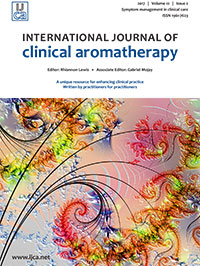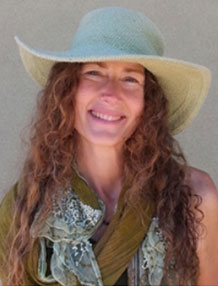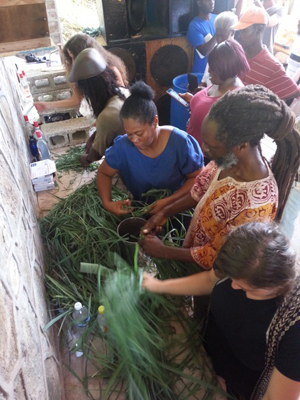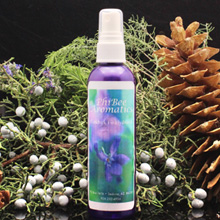International Journal of Clinical Aromatherapy interviews Clare Licher
2017, Vol 12, Issue 2
Interview conducted by Rhiannon Lewis
Sharing skills, passions and potentials: an example of a collaborative distillation project in Jamaica
 Introduction
Introduction
Clare Licher began studying medicinal herbs in 1987, has completed a 235-hour AIA and NAHA approved Aromatherapy Certification Program, and is currently studying Alchemy. She writes articles and speaks on native essential oils of the American Southwest, and on the ecological roles of many of these aromatic plants. She has consulted and worked on a project in Iceland, is currently working on a USAID funded, ‘Partners of the Americas’ administered project in Jamaica, and is also consulting on several other projects in the Caribbean. Together with her husband, Max Licher, an avid botanist and plant photographer, Clare began studying the native plants of the American SW in 1992, bought their first still in 2005, and started PhiBee Aromatics (a family run business, named after their daughters). They are located in Sedona, Arizona, and specialize in sustainably wild crafted native plants from seven different ecosystems in Arizona. In this interview Clare describes the recent distillation project in Jamaica.
Interview
Clare, how did you become involved with the Jamaica essential oil distillation project?
 In February 2016, I was contacted by Partners of the Americas, and asked if I would be interested in taking a Farmer-2-Farmer volunteer assignment in Jamaica. Kwao and Agape Adams of Yerba Buena Farms were requesting assistance in improving their distillation system. They had been working with a small distillation apparatus since 2012 that they bought to produce essential oils for their soap making business. They were wishing to increase their yield of oil from this still, and were also looking for someone to teach workshops to inspire the community about essential oil distillation of the plants of Jamaica.
In February 2016, I was contacted by Partners of the Americas, and asked if I would be interested in taking a Farmer-2-Farmer volunteer assignment in Jamaica. Kwao and Agape Adams of Yerba Buena Farms were requesting assistance in improving their distillation system. They had been working with a small distillation apparatus since 2012 that they bought to produce essential oils for their soap making business. They were wishing to increase their yield of oil from this still, and were also looking for someone to teach workshops to inspire the community about essential oil distillation of the plants of Jamaica.
The Farmer-2-Farmer program exists to teach skills on a grass roots level to communities, to help increase their food security, health and self-sufficiency. The length of time for the assignment was between two and four weeks, and had to be carried out sometime between April and June, 2016. I initially thought this would be impossible at such short notice. After several days of finding myself unable to think about anything else, I began looking more seriously at the calendar to see when I could go, and I purchased several ethnobotanical books on Jamaica.
What was it in particular that interested you about this assignment?
There were many aspects that I found interesting! In the project description, Yerba Buena Farm had included a list of 27 well known aromatic plants that are found on Jamaica, from which we could choose to work with. Several of them had been my dream to distill someday. Vetiver, bay St Thomas, and allspice are abundant native plants, while lemongrass, nutmeg, cinnamon, turmeric, ginger and ylang ylang are just a few of the introduced plants that have been successfully cultivated or naturalized. As I began reading the ethnobotanical books of Jamaica, I realized that, like the US Southwest, there were many native species of aromatic medicinal plants that had no record of distillation. I felt so excited about the possibilities! It gave me the confidence that I could inspire others in the workshops.
 A wonderful group of people |
 Beach at Yerba Buena Farms |
I was also struck by Yerba Buena Farm’s spirit of generosity and community support. They had previously hosted other Farmer-2-Farmer volunteers, who taught bee keeping, top bar hive construction, and trainings for creating value added products from beeswax. They themselves then went on to train over 1,000 beekeepers in Jamaica! Beekeepers were among the long list of people who were interested in the distillation workshops. There were also farmers, officers from the Rural Agricultural Development Agency, health care professionals, cottage industries, scientists, educators, and massage therapists. How could I pass up the opportunity to meet so many wonderful Jamaicans at once, share my love of working with plants and distilling, and stay on an organic farm with a small, secluded beach?!
Once all of the arrangements were made, I had about six weeks to give myself a crash course on distilling tropical plants. I buried myself in the six-volume set of books by Ernest Guenther concerning essential oil distillation worldwide and also interviewed other distillers that I knew had experience in working with some of these plants. This study resulted in the compilation of two notebooks, each three inches thick, with articles and as much information as I could find on the original list of 27 aromatic plants. I then brought these to Jamaica as a gift to Yerba Buena Farm.
Were you able to improve the function of the still?
Yes! Yerba Buena Farm’s distillation system was converted from an alcohol to an essential oil still. The basket for holding the plant material was too small and a lot of valuable space inside the retort was being wasted. We immediately set out for Kingston to see if we could find a fabricator that could help us. Everywhere we went, we were advised to go somewhere else. It was an exhaustive search, but our sixth and final lead brought us to “Faith Fabrication and Welding”. They had a piece of strong stainlesssteel mesh in their yard, and were able to make what we needed that very afternoon.
The next day we distilled lemongrass that was growing on the farm, and had an exciting yield of aromatically beautiful essential oil. I was greatly relieved because this was key for the success of the trainings, which were starting in two days!
What can you tell us about the workshops?
We had a fantastic turn out. People came from 12 of the 14 Parishes, and some drove up to four hours to get there. We trained 120 people, and I was overwhelmed by the enthusiasm! We did three public workshops, and a private one for the Rural Agricultural Development Agency. People asked such great questions. It was clear that they had been thinking about distilling Jamaican plants for a long time. We had piles of lemongrass for the trainings, and everyone who wanted to, got a chance to participate in processing the plant material before distilling it. They were long days, but most people hung in there to see the final yield of essential oil. Many participants expressed a desire for further trainings and to work with more Jamaican plants. It quickly became clear that there was more work to do!
 Processing Lemongrass |
 Agape washing Vetiver |
What were the goals of the second assignment in Jamaica?
Although we had increased the yield of essential oil from the still, there was much need of improvement in efficiency. We initially used a bucket with ice water and a pump for cooling the condenser, which worked fine for distilling lemongrass in the trainings, but it was not a sustainable process for the longer distillations that Yerba Buena Farm was wishing to do. Ice is very expensive in Jamaica, and the nearest store selling it was a substantial distance away. After the workshops on the first assignment, we needed to focus our remaining time on more distillation experiments and the trip report, so we were unable to deal with this issue. In spite of the condenser difficulty, we distilled Croton linarius (sea rosemary), Vetiveria zizanioides (wild vetiver), Pimenta dioica (pimento leaf), and Rosmarinus officinalis (rosemary).
In April 2017, Partners of the Americas sponsored another Farmer-2-Farmer assignment to increase the efficiency of the distillation system and research a wider variety of aromatic plants.
Yerba Buena Farm is fortunate to have a spring on their property, and their water tank is above the area where their still is set up. It appeared as though it could provide a perfect gravity feed for the condenser, as long as the water was cool enough. Kwao added a new line from the bottom of the tank, which could be connected directly to the condenser. It was an instant success! We were all delighted when we did the math. Running the condenser had previously cost $7.50 per hour in ice, and sometimes distillations had to be cut short because of running out of ice. With the new spring water gravity feed, the condenser cost about 0.20 cents per hour to run (which is the cost of the gas to pump the water into the tank). This meant that they could now distill whenever they wanted, run all distillations to completion, and could afford to experiment with plants that might have low yields of essential oils. They also set up another tank for collecting the warm condenser water.
Our first experiment during this second assignment was with Cedrella odorata (Jamaican cedarwood) from the farm. This was a long distillation, which would have been difficult before altering the condenser. The yield and the aroma were fantastic! We immediately did a second distillation of the cedarwood shavings soaked in water first, to see if this would increase the yield. We were able to see that it did not, and shut down the distillation without the heavy feeling of having wasted a lot of time, energy and money. We went on to distill Wedelia trilobata (marigold), Vetiveria zizanioides (wild vetiver), Lantana camara (red sage), Philodendron lacerum (wicker roots), Citrus aurantium (sweet orange) and many distillations of Pimenta dioica (pimento leaf).
What can you tell us about the plant life of Jamaica?
Jamaica is a top-ranking country in the world for plant diversity, and it has an extremely lush environment. There are around 3,200 species of plants, 27% of which are endemic. About 800 square kilometers of the John Crow and Blue Mountains are established protected areas. There are 230 species of orchids, 60 species of pine, 569 species of ferns, and a large number of fruiting and aromatic introduced species.
Medicinal plant use in Jamaica dates back thousands of years. It is thought that the Native Americans arrived in several waves from South America between 5,000 BC and 600 AD. The most recent arrivals were the Taino people. They named the island Xaymaca, which means “land of wood and water”. In the 1600’s, the ethnobotanical tradition was added to by the Ashanti people, from Ghana, Africa. The English names given to them were the Coromantee or Maroons. They escaped slavery and established villages high up in the Blue Mountains. Their villages are still alive and well, and their knowledge has now been passed down through seven generations of herbalists! People come from all over the world to be healed by the traditional plant medicine and beauty of Jamaica.
Are there any special oils or hydrosols that might be exciting new additions to aromatherapy?
Absolutely! Almost everything that Yerba Buena Farm has distilled has interesting potential, but here are just a few:
The Pimenta dioica (pimento) leaf oil is wonderful. This isn’t exactly brand new, as there is a history of commercial pimento berry (allspice) distillation in Jamaica, but the leaves have mostly been considered inferior with lower levels of eugenol, and have generally been discarded. The trees are native and plentiful, and the berries have an extremely high yield of essential oil. Ernest Guenther mentioned in his books, that the amount of eugenol contained in the berry oil increased from the south to the north of the island, reaching up to 56%. Yerba Buena Farm is on the north shore of Jamaica. We distilled the leaves on my first visit there, and I immediately loved the warm, sweet and spicy aroma. The leaf oil has lighter than water components, but quickly changes to producing heavier than water oil in the distillation process. We had the leaf oil analyzed, and it contains 86% eugenol.
Wedelia trilobata (marigold - known as Mary Goules in Jamaica) is another abundant native plant. It has a long history of herbal usage, and is known to help shrink growths. We planned my second visit so that we could distill this plant on the full moon, because that is the time when its benefits are said to be the strongest. Yerba Buena farm had distilled it several times throughout the previous year, and had seen the oil shrink a 12-year-old growth on the lip of one of their interns. Commercial production of the essential oil may not be likely because the yield is very low, but there is always a nice amount of hydrosol! One of the farm dogs was suffering from viral papillomas, mainly in his mouth, but elsewhere on his body too. We bathed him with the hydrosol and noticed that two days later the growths were markedly smaller. We bathed him once more, and they disappeared!
The aroma of the Vetiveria zizanioides (wild vetiver - known as khus khus or bang grass in Jamaica) oil and hydrosol is superb. The oil is so thick that it took almost one year to mature. It is similar in aroma to the Haitian Vetiver, but still has its own unique signature. The cohobated hydrosol is very rich and soothing. It is a very labor-intensive plant to work with, as we found out, but luckily it also has a nice yield of essential oil.
Have analyses been conducted on these oils?
Shortly after my first trip to Jamaica, I met Melani Kovač at botanica2016. She is the founder of the Aromainstitut in Ljubljana, Slovenia, and has now launched the International Dropsmith Project. Dropsmith is a web application that is a worldwide comparative survey of essential oil chemistry. She collaborated with the Chair of the Department of Pharmaceutical Biology, Dr. Damjan Janes, and Dr. Nina Kocevar Glavac, at the University of Ljubljana, to create a program for graduate students to analyze and research essential oils. She asked if I might be interested in contributing our oils from the Southwest US, in exchange for the GC/MS reports. My answer was, of course, “Yes!” Later, I asked her if she and her team would also be interested in including oils from Jamaica, to which they answered, “Yes!” It is a beautiful international co-operative effort that is a win-win for everyone! So far, besides about 40 Southwest essential oils, they have analyzed Jamaican vetiver, pimento leaf, sea rosemary, and lemongrass. They soon will be receiving many more samples from Jamaica, such as Eupatorium odoratum (Jack ‘na Bush), Wedelia trilobata (marigold/ Mary Goules), Hyptis suaveolens (wild spikenard/ Pick Nut), Cinnamomum zeylanicum (cinnamon leaf), Cedrella odoratum (Jamaican cedarwood), Peperomia pellucida (pepper elder), Citrus aurantium (sweet orange), Lantana camara (red sage), Lantana involcrata (sea mint) and Lippia geminata (colic mint), just to name a few.
 Distilling Vetiver at night |
 Firing up the distiller |
What progress has been made since these assignments?
Because of the new condenser cooling system, Yerba Buena farm has been able to do an amazing amount of distilling. They have conducted almost 200 distillations in the last year, and have worked with over 30 different species of plants. They are taking notes on everything they distill and are compiling books and research on the native and introduced plants. They have hosted a number of interns for both beekeeping and essential oil distillation, and this past summer sometimes did two distillations per day. They now have a JEODP Facebook page, which is a forum for community sharing of information, and they are working on a website.
And finally, Clare, are there any future goals of this project?
Yes! We are hoping to design a prototype distillation system that could be manufactured in Jamaica. Import taxes are extremely high in Jamaica, making it almost impossible for the average Jamaican to afford even poor quality essential oils, much less a still. It is our hope to make artisan distillation accessible to anyone who wishes to distill essential oils. Locally made distillation systems would open up the possibility of communities of people working together to create quality essential oils. This could improve many people’s lives! For example:
- Farmers with existing crops of aromatic plants, or who wish to cultivate them, could produce and sell their oils.
- Cottage industries, massage therapists, and people in the health care field could afford to add locallymade essential oils to their products, making them more attractive to wellness centers, spas, resorts, visitors, clients and the local community.
- Beekeepers could scent their lotions and candles, also making them more attractive to customers.
- Households could improve the health and immunity of the entire family, and use non-toxic cleaning products that would also be less harmful to the environment.
Many communities around the world are working together to create specialties from their unique heritage and surroundings. Artisan essential oil distillation has a role to play in this positive social change. It is an inspiring process that brings us back to paying attention to and working more closely with nature, and it strengthens our sense of place.
I am very grateful to Partners of the Americas, Farmer -2- Farmer program for supporting this project in Jamaica.


